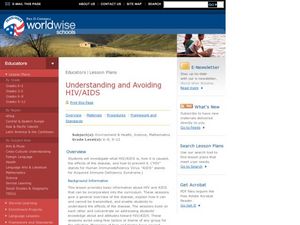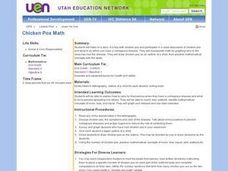Howard Hughes Medical Institute
Viral DNA Integration
How do viruses hijack our cells to produce more viral particles? Junior immunologists model how viral RNA integrates into a host cell's DNA using pop beads and use interactive tools to explore a virus' genome. The teacher's guide...
Nemours KidsHealth
Germs: Grades 9-12
Beware the bugs! Two activities engage high schoolers in the study of germs, what they are, what they do to the body, and what can be done to prevent them from spreading. After reading a series of related articles, groups create a...
Curated OER
Fighting Back!
Fifth graders inspect the basic functions of the immune system and determine how viruses and bacteria invade the immune system. They also explore what happens to the immune system in outer space.
Curated OER
Antibodies and the Immune Response Lesson Plans - Biology Teaching Thesis
High schoolers are introduced to bacteria and their role in biology and finishes with a lab experiment that focuses on antibiotics. They are given an overview of the important concepts involving bacteria and their potential resistance to...
Curated OER
TE Activity: Hot or Not
Students examine how the human immune system responds to germs and explain what a fever is. They design a thermometer in order to further explore temperature before completing a temperature conversion worksheet. They detail the work of...
Curated OER
Investigating the Method by Which the Body Defends Against Pathogens
Students explore disease caused by bacteria and viruses, how they are transmitted, and how they exert their effects on their hosts. They explain how diseases, such as AIDS, are spread by exponential growth.
Curated OER
Viral Hijackers
Students discover how viruses effect living organisms. Focusing on HIV, they explain why it is unique and how it attacks the immune system. They simulate the spread of viruses through an experiment using water containing sodium...
Curated OER
Gregory Carter
Students explore how the immune system, fights a war with a pathogenic organism: one of the many bacteria, viruses, and protozoans that can infect our bodies and cause disease.
Curated OER
Why Does My Body Smell?
Fourth graders investigate how germs spread among people. In this health activity, 4th graders discover the causes of infection and proper hygiene methods.
Curated OER
Launch Biotechnology into Your Classroom: Drug Delivery and Diffusion
Young scholars distinguish between diffusion and osmosis and describe ways that drugs can be administered. In this diffusion lesson plan students research career paths and create a presentation to give to the class.
Curated OER
Muscles and Motor Locomotion
This is a fabulous presentation which should reinforce all aspects of muscle construction on a gross anatomical and micro level. There are slides to help understanding with the muscle fiber anatomy, and many labelled diagrams to...
Curated OER
Crime Scene Investigation - Biology Teaching Thesis
Students explore the different blood types, and are introduced to new knowledge through a crime scene simulated activity. They explore the genetics of blood types, and are introduced to immunology/diseases.
Curated OER
Understanding and Avoiding HIV/AIDS
Students explore myths and facts pertaining to AIDS. In this AIDS/HIV lessons, students listen to their instructor deliver a lecture regarding the disease and then play a true or false game based on the lecture.
Curated OER
Benefits of Nutrients
Explore the nutrients a body needs using this resource. Learners discuss the importance of the relationships between proteins, fats, carbohydrates, vitamins, minerals, and water. It's a great way to have your class talk about the healthy...
Curated OER
Understanding and Avoiding HIV/AIDS
Students begin the lesson by discussing what they already know about their immune system. In groups, they participate in a true and false game using the facts and myths of HIV/AIDS. They discuss how the disease is affecting their country...
Curated OER
Cold and Flus
Students investigate the difference between viral and bacterial illnesses. In this health lesson, students learn the symptoms of each and examine ways to prevent spreading virusus and bacteria.
Curated OER
Spread of Disease
Seventh graders discover facts about the human body. For this diseases lesson, 7th graders understand different kinds of diseases, how disease spreads, how diseases have changed and preventative medicines. Students debate different...
Curated OER
Chicken Pox Math
Students will listen to a story of a boy with chicken pox and participate in a class discussion of chicken pox and what to do when you have a contagious disease. They will incorporate math by graphing who in the class has had the...
Curated OER
Chicken Pox Math
Second graders are read a story about a boy with chicken pox. As a class, they discuss what to do when you have a contagious disease and identify who in the class has had chicken pox. Using this information, they create a graph and use...
Curated OER
DNA Fingerprinting with Gel Electrophoresis
Young scholars use DNA fingerprinting to demonstrate the concept that DNA fingerprinting can be used to identify individuals and solve problems. They use gel electrophoresis to analyze the DNA of a suspected criminal to prove innocence...
Curated OER
All About HIV and AIDS
Learners use the internet to research the causes, effects and how AIDS is transmitted from person to person. In groups, they discover why women are more suseptiable to the disease. To end the lesson, they are introduced to the various...
Curated OER
Viruses Quiz
In this science worksheet, students will test their knowledge of viruses. Students answer ten multiple choice questions pertaining to virus characteristics.
Curated OER
Stay Well
Students complete a three part activity lesson to identify elements of longevity in life expectancies and health. In this life expectancies lesson, students read background information about life expectancy data, and visit links to for...
Curated OER
The Screwtape Letters by C.S. Lewis (Letter 28)
After reading Letter 28 of The Screwtape Letters by C.S. Lewis, learners provide definitions for vocabulary words and answer 11 reading comprehension questions about what they read.

























